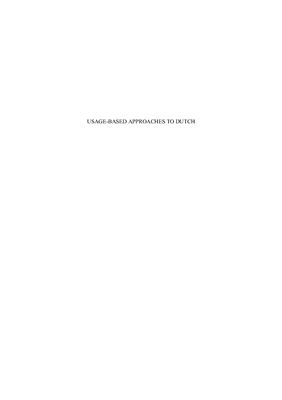Издатель: Utrecht
Год издания: 2010
Количество страниц: 213
ISBN 90-76864-47-0
Язык: English
On March 22 and 23, 2000, Leiden University hosted an inteational symposium under the title ‘Language, Culture, and Cognition’. The organizers (Vincent van Heuven, Jeroen van de Weijer, and Jos? Birker) had decided that the presence in Leiden of a number of interesting linguists at the time provided an opportunity for a workshop that should not be passed up. They succeeded in persuading the participants to speak at the symposium, and Leiden University to sponsor it. At the end of the second day, the organizers and the participants agreed that despite the diversity of the topics addressed, there had definitely been more than one
common underlying thread. One of these was the central position assigned to meaning and function in explaining linguistic phenomena, another the large role played by the analysis of actual utterances to lay an empirical foundation for the hypotheses being investigated, and a third one the ambition to account for characteristics of linguistic systems and for linguistic usage simultaneously, using the same conceptual tools. It was this sense of commonality that made us conclude that we should definitely pursue the somewhat vague plan for a volume that we already had before the symposium. The diversity just mentioned conceed the levels of linguistic description, which ranged from that of bound morphemes (the smallest meaning bearing units) to texts (the most composite sort of structural and functional linguistic units). But many contributions to the symposium testified to the idea that the application of some form of usage-based approach actually reveals cross-level similarities. Slightly twisting an English proverb, one of these similarities that is arguably most important may be summarized as: ‘The sting is in the detail’.
Год издания: 2010
Количество страниц: 213
ISBN 90-76864-47-0
Язык: English
On March 22 and 23, 2000, Leiden University hosted an inteational symposium under the title ‘Language, Culture, and Cognition’. The organizers (Vincent van Heuven, Jeroen van de Weijer, and Jos? Birker) had decided that the presence in Leiden of a number of interesting linguists at the time provided an opportunity for a workshop that should not be passed up. They succeeded in persuading the participants to speak at the symposium, and Leiden University to sponsor it. At the end of the second day, the organizers and the participants agreed that despite the diversity of the topics addressed, there had definitely been more than one
common underlying thread. One of these was the central position assigned to meaning and function in explaining linguistic phenomena, another the large role played by the analysis of actual utterances to lay an empirical foundation for the hypotheses being investigated, and a third one the ambition to account for characteristics of linguistic systems and for linguistic usage simultaneously, using the same conceptual tools. It was this sense of commonality that made us conclude that we should definitely pursue the somewhat vague plan for a volume that we already had before the symposium. The diversity just mentioned conceed the levels of linguistic description, which ranged from that of bound morphemes (the smallest meaning bearing units) to texts (the most composite sort of structural and functional linguistic units). But many contributions to the symposium testified to the idea that the application of some form of usage-based approach actually reveals cross-level similarities. Slightly twisting an English proverb, one of these similarities that is arguably most important may be summarized as: ‘The sting is in the detail’.

